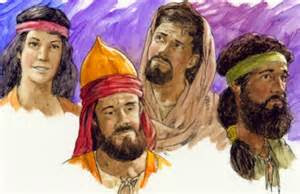Let's take a break this week from the lineage history of the Nephites to return to some archaeological locations for Book of Mormon cities extending out from the central hub of Zarahemla. When Alma the Younger set out on his mission north and westward from Zarahemla, the Book of Mormon gives some fairly accurate data as to the direction he went and the number of days it took him to get there. These days can translate into miles based on the number of days a man could walk.
Book of Mormon scholars can then start at Zarahemla/Santa Rosa, map out the direction and the miles to where a Nephite city is mentioned. Something should be there - and it is. This is how they reconstruct Alma's missionary journey and tie it in to existing areas in Mexico. (Remember that Santa Rosa archaeological site, the logical location for Zarahemla, was flooded with the building of the Agostura Dam on the Grijalva River, creating Agostura Lake shown above.)
Speaking of this time in Nephite history, Sorensen calls it the time of "growing pains." He writes in his book An Ancient American Setting for the Book of Mormon: Mosiah's people obviously existed in a complex social setting. Language and cultural differences in the kingdom were great. (p. 191) Sorensen then identifies at least 3 different cultural groups within Mosiah's kingdom:
- The original people of Zarahemla who were descendants of Mulek and who had migrated south from La Venta/Mulek long before the Nephites arrived. They were of the tribe of Judah and spoke the ancient language of Zapotec/Mixtec. Remember, when the Nephites came, the people of Zarahemla couldn't understand them and vice versa. They had no written records with them, so their language and traditions were heavily impacted by the indigenous peoples of La Venta: the Olmecs. They were the largest group and outnumbered the Nephites two to one.
- The Nephites who came down from the Land of Nephi when the first Mosiah was the king. They had written records, so there language suffered less of an impact by other indigenous people than did that of the Mulekites or the Lamanites. There records also gave them a religious history, so there traditions were impacted strongly by the Law or Moses, which they observed.
- The Nephites who came out of the Land of Nephi several generations later with Alma and Limhi. They spoke the Nephite language, but their religious traditions had been corrupted by the false teachings of King Noah and his priests. Alma's people were back on track due to the teachings of Abinadi that Alma had recorded, but the people of Limhi were still far afield from living the Law of Moses. They had to be taught the gospel from Alma when they arrived in Zarahemla.
- I'm adding a fourth group: the adult children of the priests of Noah and their Lamanite wives. They would have had serious language, religion, and cultural traditions from both sets of parents and also had to be taught the gospel by Alma. They probably spoke Nephite, although they might have spoken Lamanite as well.
Clearly, Zarahemla was a center of ethnic, linguistic, and cultural mixing . . . (p. 191)
Text copyright August 2013, Gebara Education
Pictures:
Map from www.poulsen.org
Lake from www.flickr.com
Peoples of the Book of Mormon from www.nephicode.blogspot.com
Mural from www.rationalfaiths.com




No comments:
Post a Comment